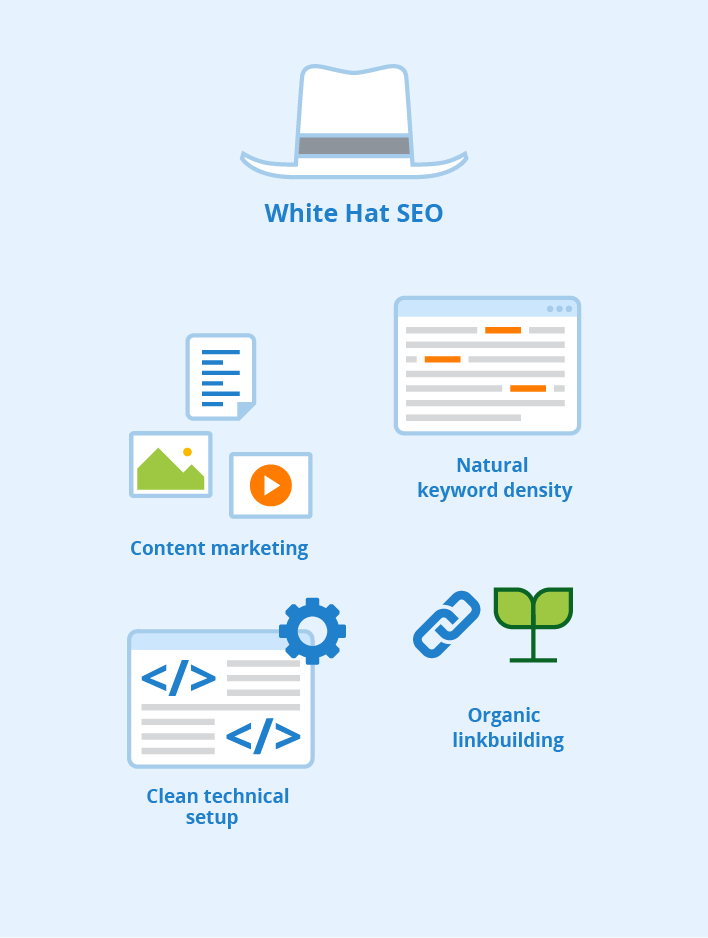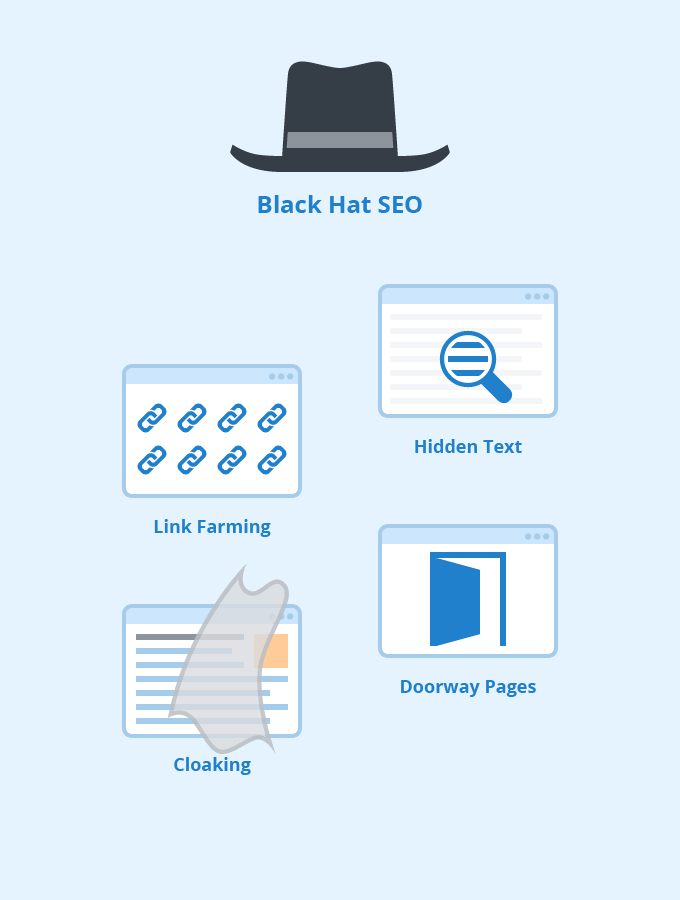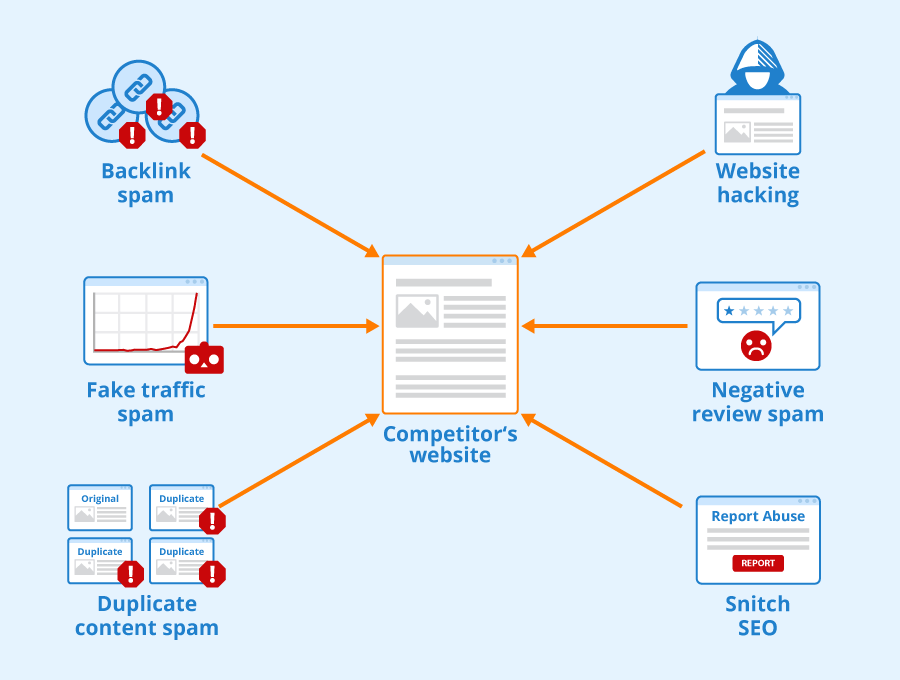SEO, or Search Engine Optimization, helps enhance your website’s visibility on Google search results for relevant keywords. This leads to increased organic traffic. Users often choose from the top 10 search results, which are well-optimized using SEO. Let’s explore the 12 types of SEO that improve website rankings.
1. On-Page SEO (On-Site SEO):
On-site SEO involves optimizing elements on your website, such as content and HTML code, to enhance search engine rankings. This differs from off-site SEO, which focuses on external factors like backlinks and social media.
– SEO Keyword Research: Identify relevant keywords and strategically use them in your content to boost search engine visibility.
– Quality SEO Content: Create user-friendly and search engine-friendly content that includes relevant keywords and attracts links and shares.
– Internal Linking: Connect relevant pages within your website to improve user experience and help search engines understand your content.
– Metadata SEO Optimization: Optimize title tags, header tags, and meta descriptions to accurately convey page content to both users and search engines.
– Image SEO Optimization: Optimize images with descriptive file names, alt tags, and captions for better user experience and search engine visibility.
– URL Structure: Organize URLs with relevant keywords to improve search engine understanding and user experience.
2. Off-Page SEO (Off-Site SEO):
Off-page SEO boosts search engine rankings by optimizing factors outside your website. This includes building backlinks, using social media, and online marketing.
– Guest Blogging: Write articles for other websites and include backlinks to improve your website’s visibility and authority.
– H.A.R.O: Respond to journalists’ queries for media exposure and backlinks.
– Competitor Research: Analyze competitors’ backlinks, content, and keywords to refine your own strategy.
– Internet Ads: Place paid ads on external sites to drive traffic and leads.
– Press Distribution: Share press releases for backlinks, customer attraction, and brand recognition.
– Brand Signals: Build your brand’s online presence through social media engagement and mentions on other sites.
3. Technical SEO:
Technical SEO improves website accessibility for search engines and visitors.
– Site Load Time: Optimize site speed for better user experience and rankings.
– Mobile-Friendliness: Design your site for mobile devices to ensure quick loading and easy navigation.
– Crawl Error Identification: Find and fix errors that hinder search engine access to your content.
– Keyword Cannibalization Audit: Resolve issues where multiple pages compete for the same keywords.
– Duplicate Content Audit: Identify and fix duplicate content that affects rankings.
– Site Structure: Create an organized structure for easy navigation and understanding.
4. International SEO:
International SEO targets diverse areas and languages for improved organic traffic. Adapt to local cultures and languages, use correct formats, and communicate in native languages for better user experience.
5. Local SEO:
Local SEO boosts visibility for local businesses in Google search results. Understand local search behavior to improve rankings and appear in the local map pack, driving local traffic.
6. E-commerce SEO:
E-commerce SEO helps online stores rank higher in search results, attracting potential customers. Focus on homepage SEO, analyze competitors, and optimize your website architecture to increase traffic.
7. Content SEO:
Content SEO involves creating unique and engaging content, incorporating good copywriting, site structure, and keyword strategy. Continuously monitor and adjust your content to maintain high search result rankings.
8. Mobile SEO:
Mobile SEO refers to optimizing a website for search engines while ensuring it displays correctly on mobile devices like smartphones and tablets. Providing a positive mobile experience is crucial to retaining customers. Implementing this type of SEO means aligning your site’s design, structure, and speed with mobile usability to prevent users from getting frustrated and leaving.
9. White-Hat SEO:
White-hat SEO involves practices that adhere to the guidelines set by major search engines, including Google. It aims to enhance search engine rankings while upholding your website’s integrity within the search engine’s terms of service.
Here are some essential white-hat SEO practices to strictly follow:
– Use descriptive, keyword-rich meta-tags.
– Deliver high-quality content and services to your website visitors.
– Ensure your website is user-friendly and easy to navigate.
10. Black-Hat SEO:
Black-hat SEO takes advantage of weaknesses in search engine algorithms to attain higher positions in search results. Techniques like spammy link-building, keyword stuffing, and cloaking are used for quick gains. While these tactics can provide immediate results, they risk damaging your website’s reputation and rankings if search engines detect them. It’s advisable to steer clear of black-hat SEO.
11. Gray-Hat SEO:
Gray-hat SEO practices fall between white-hat and black-hat categories due to their uncertain adherence to terms and conditions. While gray-hat practices don’t typically lead to site bans, they still involve some level of risk. Understanding and using gray-hat practices can help you make informed decisions to avoid negative consequences and adopt ethical practices.
12. Negative SEO:
Negative SEO is an unethical strategy aimed at undermining competitors’ search rankings to gain a competitive edge. Tactics include creating a large number of low-quality links or posting negative reviews about competitors on forums. Engaging in negative SEO can lead to legal issues and tarnish your online reputation.
Read More: Exploring the 4 Types of SEO: A Simple Guide for Small Businesses
Frequently Asked Questions (FAQs) about the 12 Types of SEO:
1. What are the 12 types of SEO?
The 12 types of SEO encompass a range of techniques to enhance a website’s visibility and performance. These include On-Page SEO, Off-Page SEO, Technical SEO, Mobile SEO, Local SEO, International SEO, E-commerce SEO, Content SEO, White-Hat SEO, Black-Hat SEO, Gray-Hat SEO, and Negative SEO.
2. How does On-Page SEO differ from Off-Page SEO?
On-Page SEO involves optimizing elements within your website, such as content and metadata, to improve rankings. Off-Page SEO focuses on external factors like backlinks and social media engagement to enhance your site’s authority and reputation.
3. What does Technical SEO involve?
Technical SEO focuses on optimizing the technical aspects of your website for better search engine crawling and indexing. This includes site speed, mobile-friendliness, error identification, and proper site structure.
4. How does Mobile SEO impact user experience?
Mobile SEO ensures your website is accessible and user-friendly on mobile devices. With the rise in mobile usage, providing a seamless mobile experience is crucial to retaining visitors and improving search rankings.
5. What is the significance of Local SEO for businesses?
Local SEO helps businesses target their local audience effectively by optimizing for location-based search queries. It’s essential for local businesses aiming to appear in local search results and Google’s map pack.
6. How does E-commerce SEO differ from other types of SEO?
E-commerce SEO is tailored to online stores, focusing on product visibility and ranking for relevant searches. It aims to attract potential customers looking for products or services online.
7. What is White-Hat SEO and why is it important?
White-Hat SEO encompasses ethical and lawful strategies that adhere to the guidelines set by search engines. It ensures long-term success by improving rankings while maintaining your website’s integrity.
8. How does Gray-Hat SEO walk the line between ethical and unethical practices?
Gray-Hat SEO practices are neither fully white-hat nor black-hat. They carry some level of risk due to their uncertain compliance with search engine terms. Gray-hat techniques may provide benefits but can also have drawbacks.
9. What are the risks associated with Black-Hat SEO?
Black-Hat SEO relies on manipulative tactics to achieve quick rankings, but it can lead to severe penalties from search engines if detected. It’s best to avoid these practices to protect your website’s reputation.
10. How does Negative SEO impact online businesses?
Negative SEO involves harmful tactics aimed at sabotaging competitors’ rankings. Engaging in negative SEO not only damages your competitors’ reputation but can also lead to legal consequences and tarnish your own brand’s image.
11. Which type of SEO is suitable for expanding into international markets?
International SEO caters to global audiences by optimizing for different languages and cultures. It’s essential to adapt your website to resonate with diverse audiences and ensure a seamless experience for international visitors.
12. Can I learn and implement these SEO techniques on my own?
Yes, many resources and courses are available for learning and implementing SEO techniques. However, it’s recommended to stay updated with industry changes and consider professional guidance to achieve optimal results in the dynamic world of SEO.
13. What is the role of SEO in marketing?
SEO, a significant aspect of Digital Marketing, improves a website’s visibility on Google search results. It’s integrated into various Digital Marketing strategies.
14. Can I perform SEO on my own?
Yes, learning basic SEO is achievable. Online courses offer essential insights. Our SEO Training Course covers technical aspects and growth strategies. For advanced SEO expertise, explore Simplilearn’s Digital Marketing Program at IMT Ghaziabad.
Understanding these 12 types of SEO can help you optimize your website for better visibility and increased organic traffic. Incorporate these techniques to enhance your website’s performance in search engine results pages.


















